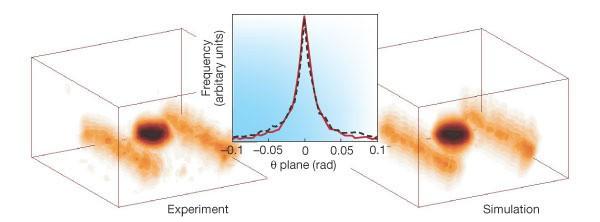利用宇宙射线μ介子进行射线成像
IF 48.5
1区 综合性期刊
Q1 MULTIDISCIPLINARY SCIENCES
引用次数: 280
摘要
天然本底粒子可用于探测隐藏的核材料。尽管 X 射线射线摄影术1 取得了巨大成功,但它也有其局限性:无法穿透高密度物体,需要多次投影才能解析三维结构,以及辐射对健康的危害。在这里,我们展示了由宇宙射线产生的天然本底μ介子,它具有很强的穿透力,可用于对中型到大型致密物体进行射线成像,而且没有这些限制,曝光时间也相当短。这种成本低廉、无害的技术可为探测致密物质提供一种有用的替代方法--例如,探测隐藏在满载绵羊的卡车内的铀块。本文章由计算机程序翻译,如有差异,请以英文原文为准。

Radiographic imaging with cosmic-ray muons
Natural background particles could be exploited to detect concealed nuclear materials. Despite its enormous success, X-ray radiography1 has its limitations: an inability to penetrate dense objects, the need for multiple projections to resolve three-dimensional structure, and health risks from radiation. Here we show that natural background muons, which are generated by cosmic rays and are highly penetrating, can be used for radiographic imaging of medium-to-large, dense objects, without these limitations and with a reasonably short exposure time. This inexpensive and harmless technique may offer a useful alternative for detecting dense materials — for example, a block of uranium concealed inside a truck full of sheep.
求助全文
通过发布文献求助,成功后即可免费获取论文全文。
去求助
来源期刊

Nature
综合性期刊-综合性期刊
CiteScore
90.00
自引率
1.20%
发文量
3652
审稿时长
3 months
期刊介绍:
Nature is a prestigious international journal that publishes peer-reviewed research in various scientific and technological fields. The selection of articles is based on criteria such as originality, importance, interdisciplinary relevance, timeliness, accessibility, elegance, and surprising conclusions. In addition to showcasing significant scientific advances, Nature delivers rapid, authoritative, insightful news, and interpretation of current and upcoming trends impacting science, scientists, and the broader public. The journal serves a dual purpose: firstly, to promptly share noteworthy scientific advances and foster discussions among scientists, and secondly, to ensure the swift dissemination of scientific results globally, emphasizing their significance for knowledge, culture, and daily life.
 求助内容:
求助内容: 应助结果提醒方式:
应助结果提醒方式:


